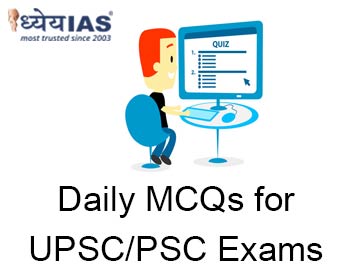Home > Daily-mcqs
Daily-mcqs 16 May 2025

Q1:
Consider the following statements with reference to Bhargavastra: Which of the statements given above is/are correct?
A: 1 and 3 only
B: 2 and 3 only
C: 1 and 2 only
D: 1, 2 and 3
Answer: A
Explanation:
Bhargavastra is India's first micro missile-based hard-kill counter-drone system—meaning it destroys drones physically rather than disrupting them electronically (soft kill). It is capable of firing over 64 micro missiles simultaneously, including in salvo mode. Statement 2 is incorrect as it refers to soft-kill methods not used in this system.
Q2:
Consider the following initiatives in the context of India's strategy to combat Naxalism: Which of the above are directly aimed at addressing the causes or consequences of Left-Wing Extremism?
A: 1, 2 and 3 only
B: 1 and 4 only
C: 2, 3 and 4 only
D: 1, 2, 3 and 4
Answer: A
Explanation:
Eklavya Schools promote tribal education, Forest Rights Act addresses historical injustices against forest dwellers, and UAPA legally targets extremist groups. PM-KUSUM, though important for solar energy promotion, is not directly related to LWE mitigation.
Q3:
Which of the following statements correctly describes Article 143 of the Constitution of India?
A: It empowers the Parliament to impeach the President on legal grounds.
B: It allows the Supreme Court to review laws passed by Parliament.
C: It empowers the President to seek the opinion of the Supreme Court on questions of law.
D: It allows Governors to consult the President on matters of state legislation.
Answer: C
Explanation:
Article 143 provides advisory jurisdiction to the Supreme Court. The President can refer matters of legal or constitutional importance, but the Court's opinion is not binding.
Q4:
Which of the statements given above is/are correct?
With reference to e-passports recently introduced in India, consider the following statements:
A: 1 and 2 only
B: 2 and 3 only
C: 1 and 3 only
D: 1, 2 and 3
Answer: D
Explanation:
E-passports issued in India include a Radio Frequency Identification (RFID) chip embedded in the cover. This chip stores both biometric identifiers (such as facial data, fingerprints) and personal/demographic data. The use of Public Key Infrastructure (PKI) ensures authenticity and security by encrypting the stored data, making it nearly impossible to tamper with or clone. This makes all three statements correct.
Q5:
Which of the statements given above is/are correct?
With reference to the Right of Children to Free and Compulsory Education (RTE) Act, 2009, consider the following statements:
A: 1 and 2 only
B: 2 only
C: 1 and 3 only
D: 2 and 3 only
Answer: B
Explanation:
The RTE Act guarantees free and compulsory education only to children aged 6–14, not up to 18 (so statement 1 is incorrect). The Act does mandate 25% EWS reservation in private unaided schools (statement 2 is correct). While ECCE is mentioned in the NEP 2020, it is not currently covered under the RTE Act (so statement 3 is incorrect).